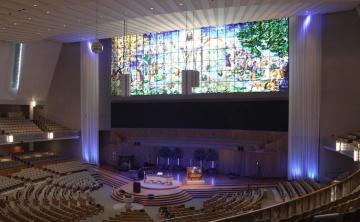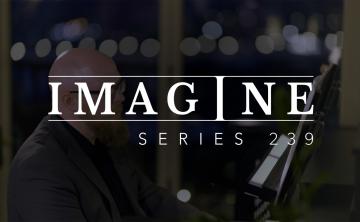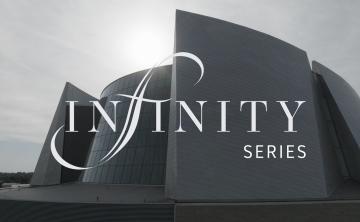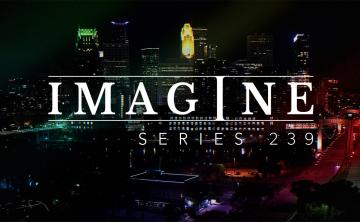Rodgers History 1955-2023
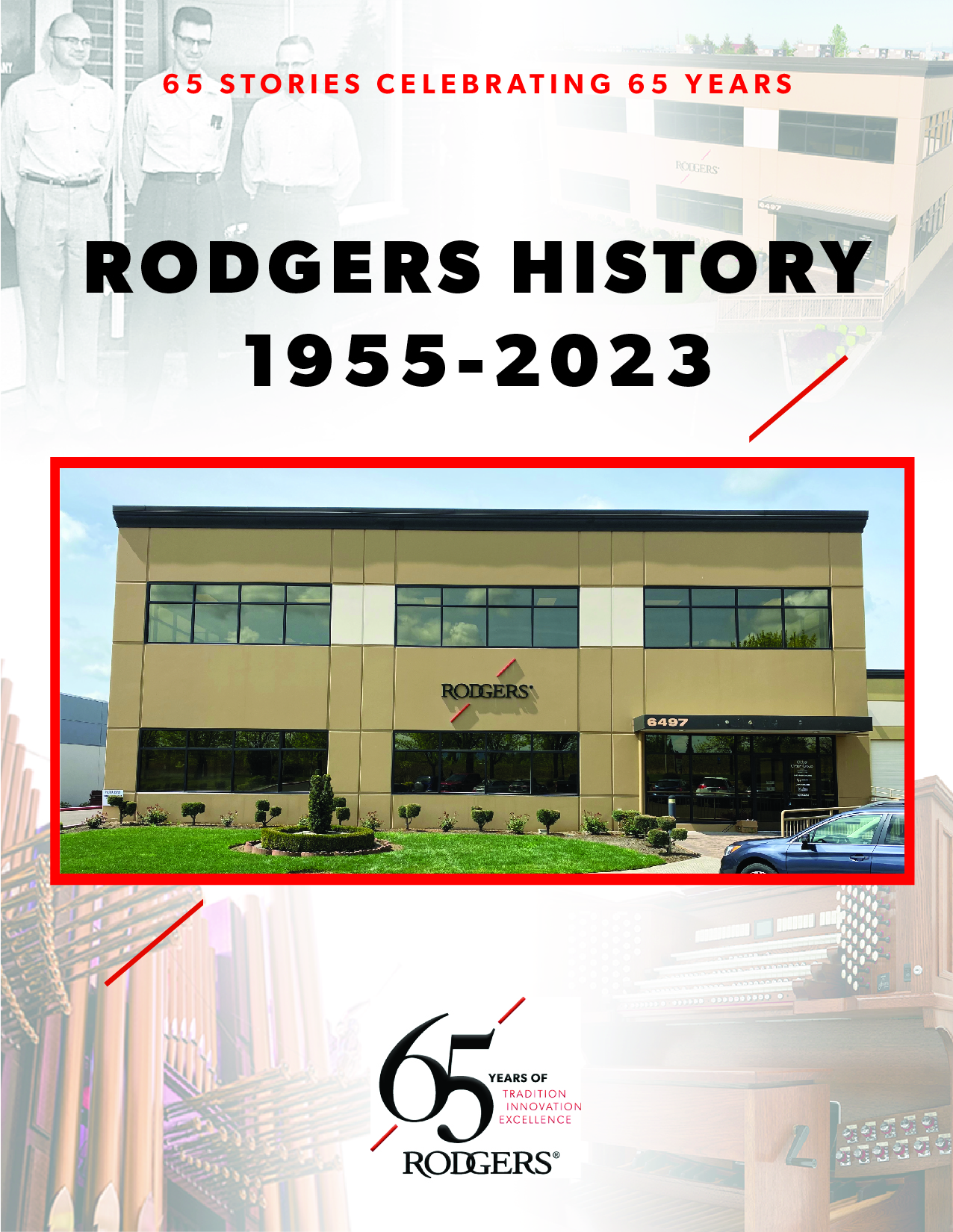
We are pleased to present a brief history of Rodgers from 1955 to 2023, which includes many "firsts" for the industry!
1955: Research engineers Rodgers Jenkins and Fred Tinker begin to experiment with the idea of an electronic organ based upon transistorized oscillator circuitry at Tektronix, Inc., a Beaverton, Oregon-based electronics test equipment manufacturer.
1957: After helping successfully design the stable transistor oscillator circuitry at Tektronix, Jenkins and Tinker suggest the company build church organs based on this new technology. The Tektronix board declines, but several board members agree to help fund a new, separate company to build “Rolls Royce quality” electronic organs.
1958: Rodgers Organ Company is incorporated on May 1 to build the world's first all-transistor church organs. The business starts in Beaverton, Oregon, with six employees in a building shared with an automobile dealership. The world’s first solid-state (all-transistor) church organs are built and sold to Lewis and Clark College, Portland, and to a church in Eugene, Oregon.
1959: The first major public performance of one of the new all-transistor Rodgers organs is at the inauguration of Oregon Governor, Mark Hatfield, on January 12, 1959.
1960: Rodgers needs more manufacturing space and moves to a 17-acre site in Hillsboro, Oregon, just west of the Hillsboro airport. Rodgers installs the world’s largest electronic organ in Portland’s Memorial Coliseum.
1961: Rodgers introduces the first single-contact diode keying system for organs. Rodgers also introduces magnetic reed switch (sealed in glass) pedal keying, now a widely used standard in pipe organs and digital organs throughout the world.
1962: Rodgers introduces the first transistorized organ amplifier and becomes the first company to offer a totally solid-state organ and amplification system.
1965: Rodgers sales successes continue, and the company begins advertising itself as the World’s Largest Builder of Three Manual Organs.
1966: Rodgers applies early digital technology to the church organ and introduces the computer capture combination action – a patented computer memory system that saves organist registrations for instant recall. This is the forerunner of all modern piston memory systems in pipe and digital organs. Rodgers’ “Black Beauty" touring organ is built for organ virtuoso Virgil Fox who uses it in nationwide concerts. Over the next decade, Fox and Rodgers are featured on television programs including Ed Sullivan, the Mike Douglas Show, the Carol Burnett Variety Show, Sid Caesar's "Your Show of Shows" and others.
1967: Rodgers produces the first organs with time-sharing (multiplexing) circuitry improving organ console reliability.
1970: Virgil Fox plays Rodgers’ “Black Beauty” organ in an All-Bach program with Joe’s Lights at the Fillmore East Auditorium, New York City’s famous rock venue. This is the first of Fox’s famous "Heavy Organ" concerts that introduced the organ to an entirely new audience.
1972: Rodgers introduces the first lighted drawknob stop controls for organs and soon finds that organists select lighted controls over the older mechanical designs three to one. The first musically successful marriage of pipes and electronics, a three-manual Rodgers Gemini organ with Ruffatti pipes, is installed in the Georgia home of Dr. Walter and Emily Spivey.
1974: Rodgers purchases the engineering records, drawings, and files of the Aeolian Skinner Organ Company after the famous Boston-based organ builder ceases operations. Rodgers installs the world’s first five-manual electronic organ in New York City's Carnegie Hall. Virgil Fox plays the dedication concert at Carnegie Hall and Fox and the Rodgers organ receive rave reviews in such publications as the New York Times and Time magazine.
1975-76: Virgil Fox tours nationally with the five manual Rodgers “Royal V” organ, a sister instrument to the Carnegie Hall organ that debuted a year earlier.
1976: Rodgers purchases the Tellers Organ Company/Lawrence Phelps pipe manufacturing operation in Erie, Pennsylvania, and becomes the first electronic organ company to build its own pipes, pipe chests, and complete pipe organs.
1977: Rodgers is purchased by CBS, Inc. The "Black Beauty" touring organ is played for the inauguration of President Jimmy Carter and continues to be used by concert artists such as Richard Morris, Joyce Jones, Ted Alan Worth, Frederick Geoghan, Keith Chapman, and Pierre Cochereau into the early 1980s.
1980: Rodgers is the first company to use microprocessors in church organs.
1981: Rodgers builds its first all-pipe organ for a local Hillsboro, Oregon church and soon is building more than a hundred organs with pipes, all-pipe, or pipe combination, each year.
1983: Rodgers is the first company to use LED (light emitting diode) stop controls on an organ.
1984: Rodgers purchases a pipe organ builder, Harrah-Van Zoeren, Inc. and incorporates the company and its employees into Rodgers expanding pipe business.
1985: Rodgers is purchased by Steinway Musical Properties.
1987: Rodgers is the first company to introduce MIDI in church organs and first to make MIDI a standard feature on its church organs. Rodgers completes the installation of the Second Baptist, Houston, organ, a custom five manual, 193 rank, 10,473 pipe, instrument that is the largest new pipe organ to be built anywhere in world since prior to World War II.
1988: Roland Corporation purchases Rodgers and announces plant expansion plans and Rodgers’ additional role in manufacturing Roland musical instruments for North America.
1990: PDI © technology is introduced - the world's first stereo imaged organ tone generation. PDI is based on paralleled digital signal processors (DSP) in a software-based organ system. This is the first use of digital signal processing and of surface mount technology in organ circuitry and of bi-amplified audio in a church organ.
1992: Rodgers introduces removable data storage in its organs with Rodgers Personal Memory Cards to store organist's registrations. Rodgers introduces Digital Dynamic Wind™, that models pipe organ wind supplies and the interactions of pipes in pipe organ tone, Random Tuning to simulate the environmental variations inherent in pipe organs, the PR-300 sequencer/sound model for organs, and the first velocity sensitive (and sealed micro switch contact keyed) keyboards for church organs.
1993: Rodgers introduces Digital Domain Expression™ a system that models pipe organ swell boxes with all their nuances realistically for the first time.
1995: Rodgers is the first organ company with Voice Palette™, a system of built-in alternative organ stops that vastly increases a church organ’s versatility by making additional tonal colors and music styles instantly available to the organist.
1999: Rodgers Trillium organs are introduced incorporating additional pipe organ modeling technologies and RSS (Rodgers/Roland Sound Space technology) - a sophisticated quadraphonic acoustic modeling technology based on research into human hearing and sound wave reflection, which lets the musician adjust the sound environment to match the music being played.
2005: Rodgers launches the Trillium Masterpiece Series organs and the Rodgers Organ Architect (ROA) online custom organ ordering system, which allows the customization of virtually every feature and specification of the organ so that each church can order exactly what they need rather only pre-determined, mass-produced church organ models. Masterpiece organs can be updated in features and voices, giving Rodgers a unique advantage over organs that cannot be reconfigured or changed after they are built.
2007: Rodgers is the first organ company with lead-free manufacturing making it fully compliant with RoHS, a European Union directive to reduce various known hazardous substances in products using computer electronics.
2008: In Rodgers 50th anniversary year, Rodgers second generation ROA is introduced further enhancing the company’s position as the world’s leading builder of custom church organs and of pipe combination organs.
2013: Rodgers launches the Infinity Series organs and the onboard Tonal Library. Many of the options previously offered on a Rodgers organ are now standard equipment. Mix and match technology gives the musician incredible artistic latitude for crafting registrations. The Pipe Integration Manager (PIM) is launched. The PIM is a simple yet sophisticated tool that allows pipe combination instruments to be configured via an Excel file. Then the file can be loaded into the organ via USB drive and the changes immediately take effect.
2015: Infinity II is launched adding functions for wireless control of digital music scores through applications and Wi-Fi functions to control playback of recorded performances and the built-in 350 hymn tunes via an iPhone or iPad with the free Rodgers app from iTunes.
2016: Rodgers Instruments is acquired by the Global Organ Group. This American addition to the Group makes the Van de Weerd family (owners) the largest manufacturers of organs in the world. The Global Organ Group includes Rodgers Instruments, Johannus, Makin, and Copeman-Hart organ companies. Rodgers moves its facility to a smaller, more economical manufacturing space at 8117 NE Jacobson Road, in Hillsboro. Rodgers dealers represent all four organ brands of the Global Organ Group.
2018: Rodgers celebrates their 60th anniversary by introducing the new Inspire Series with “DS-Core” (Direct Streaming) technology and TSS sampled reverb technology. Three Inspire Series models are launched: the Inspire 227, Inspire 233, and Inspire Classic.
2019: Rodgers launches a 3-manual Inspire Series organ, the Inspire 343.
2020: Rodgers launches the Imagine Series with the 351T (tab), the 351D (lighted drawknob), and the 351M (moving drawknobs). Rodgers continues manufacturing operations through the pandemic.
2021: Rodgers launches the Imagine Series 235; implements the Enhanced Orchestral Coupler feature; launches the PIM2, moves to a larger facility on Croeni Avenue in Hillsboro, and installs an Infinity 484 in the Gelman Stained Glass Museum in San Juan, Texas.
2022: Rodgers launches the new Infinity Series models 367 and 489; Rodgers installs pipe additions and an Infinity 484 console in one of the world’s largest churches, the Yoido Full Gospel Church in Seoul, South Korea.
2023: Rodgers launches Custom Anniversary Series Organs and Signature Edition custom organs; Rodgers presents several sales and technical training conferences for dealers and for technicians; Rodgers celebrates its 65th anniversary with a Dealer Meeting in Hillsboro, Oregon, including a new product launch; Rodgers posts “65 Stories Celebrating 65 Years” on social media and on the Rodgers website; Rodgers launches a fund-raising charitable campaign for Mercy Ships.

